There are quite a few reasons you might want to camouflage or hide your antenna installation. Perhaps you rent and do not have permission to mount an antenna on the property, maybe there is a property owner’s association that doesn’t like antennas, or maybe you just like to keep your home from looking like a porcupine. For whatever reason, you need to hide your antenna. Let’s take a look at one way of doing that.
In this scenario I want to put up a five foot high 2m/440 antenna and have chosen the Diamond X50a. This is a nice white fiberglass dual band antenna with very small radials. Being a white stick just over one inch in diameter it is pretty easy to spot in most cases, particularly if you have trees around the roof as the white will stand out against the gray and green background very well.
Finding the right colors
In my case, the background would be a couple of live oak trees so I found a suitable stick from the trees and hopped in the car headed for Home Depot. Once in the store I headed straight for the spray paint section. I remembered they had a small selection of spray paint specifically for camouflage painting (lots of hunting types around here) so I thought this would be fairly simple. What I found was surprising.
The real trick to camouflage is that you want to break up the pattern of the object you are hiding. In other words, you want a straight stick to not look like a straight stick. Even if you get a good color match, painting it a solid single color will still let it stand out pretty well because us humans are good at seeing patterns as well as colors.
This means I need multiple colors, just like the stick has multiple colors. I picked out four different colors that came closest to the colors on my stick. The odd thing is that the closest two matching colors were actually not in the line of camouflage paints. The best overall base matching color was a primer while the best match for the light patches was a paint and primer in one.
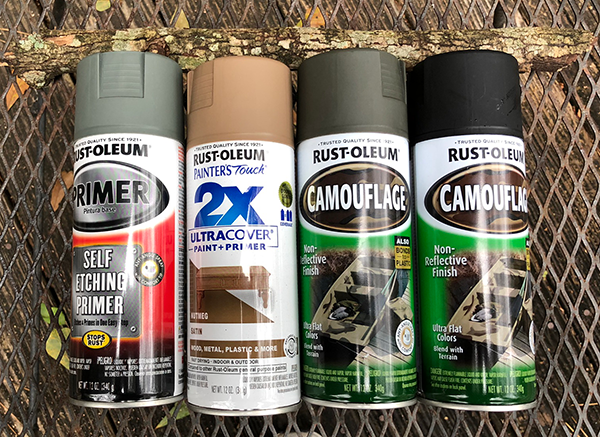
With these four colors; dark green (that looks more gray), satin nutmeg, deep forest green, and black I headed home to start the project. You can see the stick I used at the top of the image above and how well they matched the paint I bought.
Getting started
The first issue I wanted to tackle was what parts of the antenna could I paint without hurting performance. I assumed from the start I could paint the fiberglass, but what about the chrome cap on the top or the stainless steel radials? After a lot of research on the internet I learned that as long as you are not using some kind of metallic paint, you should be fine.
I started by masking off the radials and mounting area on the bottom. I did not mast the radials because I was afraid of getting paint on them, and indeed I fully intend on painting the bottom of the antenna, but I did not want paint on the bolts, threads, or mounting points which were all below the radials. This made the radials the ideal area to mask.
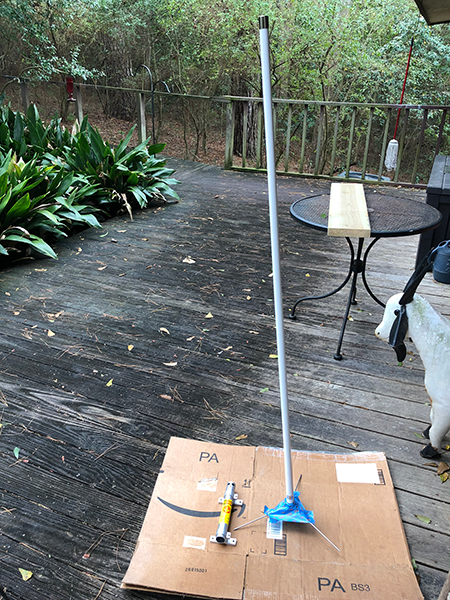
Once masking was done I used the primer I bought that was the closest overall match to the stick to paint everything. This gave me an excellent base that even as a single color would have blended in pretty well.
Since my antenna is designed to mount to a mast, I also had to paint the white mast. I attached a large washer to a string and fed the string through the mast section, then hung it from a tree. This allowed me to paint the mast without touching it, and it also made for a great picture to show you what a white pole looks like next to a tree (so you can see how obvious this would be on the roof).
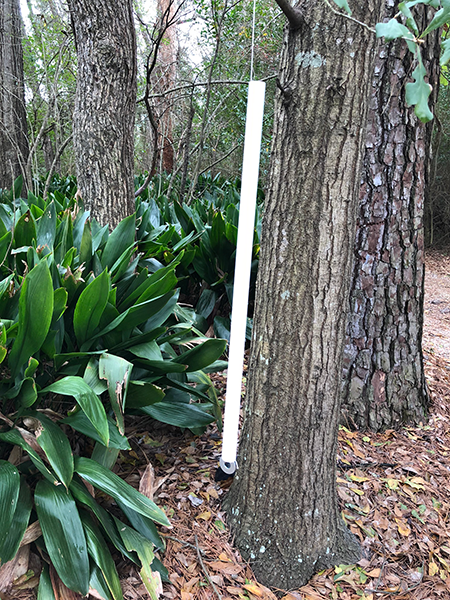
The next day I returned to really get the camo going in the right direction. Much like the oak bark was little sections of differing colors I needed a way to apply small “bark sized” patterns to the antenna. What I chose was cotton balls squeezed one direction to make them into ovals instead of round balls.
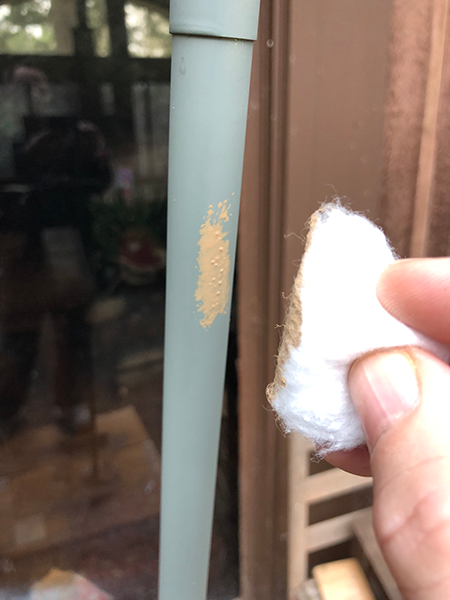
I took a plastic lid and covered it in plastic wrap so that when I was done I could just remove the wrap and throw it away. I then sprayed some of the next color paint onto the wrap, dabbed my cotton ball into the paint and then lightly tapped the ball around on the antenna trying to be unpredictable and uneven in the placements.
Remember, the goal is to break up the lines on the antenna, this is not an art project. It is actually counter productive to be neat and even, you want it to be a mess, but you also want to be very sparing with the non-dominate color application. In other words, you want just a handful of splotches of the green, tan, and black, on the gray antenna.
The final step was to paint the parts that were masked once the antenna was fully assembled. This meant taking the can of primer on to the roof with me and painting the radials, nuts, and any other bits that did not get painted on the ground.
Results
The following image was taken from directly in front of my front door so this is what anyone would see walking up to my house. Since you know there is an antenna there it should be easier for you to see, can you see it? Would you see it if you did not know it was there?
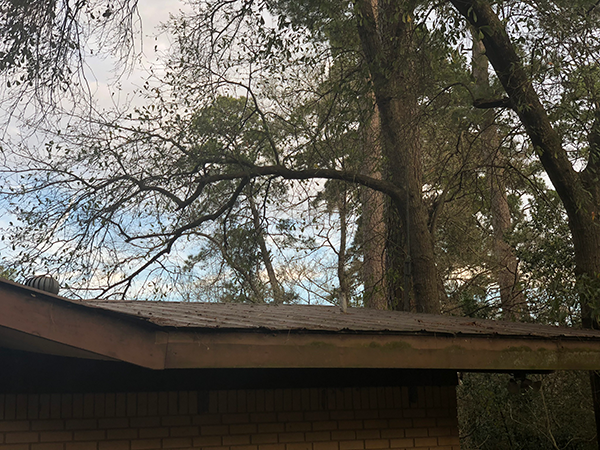
I would say it worked pretty well!
If you have a hard time finding it, try the following image. If you look really close you can see some of the splotches of paint on the antenna that look a lot like the bark behind it.
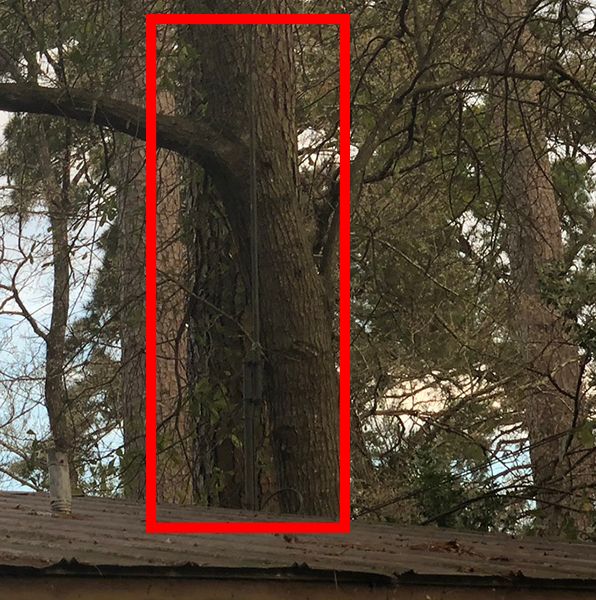
Good luck with your antenna hiding project!


I have heard the metals in pains will affect the transmit on the antenna.
Honestly, I could not tell you that with any certainty. What I can tell you is that if there is an effect on my antenna, it is so small that I don’t care. The antenna still works absolutely fantastic. I can also promise you that even if it cut your antenna range dramatically, it is better than having to remove it completely because of your HOA or a significant other who doesn’t like the looks.
Do you have any suggestions on which colors would be best for a free-standing antenna? I have a tree in front of the house but I was going to mount the mast and antenna on my deck to the rear. I planned on painting the support/mast partially to match the deck colors and the rest to blend with the sky background.
WHat I did was take a picture of the antenna from where I wanted it hidden, then went to the store and found the colors that matched areas of the picture next to the antenna. Remember that the biggest trick is to break the antenna paint scheme up as a solid line of any color will stand out. Good luck!
If you are concerned about the metal content in a paint, the information can often be looked up at your favorite hardware store. I found a spray paint that was metal-free in a brown that had no metal for my J-pole. however, it has been a while and I can’t remember the brand. The point is the metal content of whichever paint you choose can be discovered by inquiry to the manufacturer or in the Material data safety sheet (MSDS) for the paint. Good luck and 76.